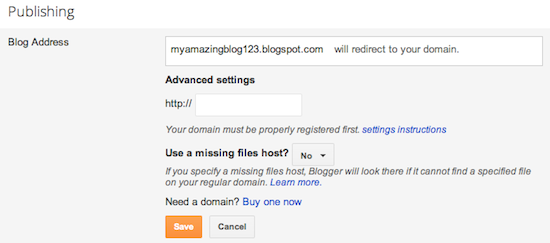News
Saturday, March 5, 2016
How do I use a custom domain name for my blog?
There are two ways you can publish your blog on Blogger - either by hosting it on Blogspot (example.blogspot.com) or hosting on your own custom domain (www.example.com or foo.example.com). You can change where your blog is published at any time, and it won't cause you to lose any content on your site.
First, purchase a custom domain
Before you move your blog to a custom domain, you need to have already purchased a custom domain from another provider.
There are many companies you can buy domain names from, including:
Tip: If you're in the United States, you can also integrate Google Domains with Blogger.
If your site's content is in a different language and you'd like to purchase a country-specific domain, you can do a search to find local registrars. For example, if your blog is in French and you'd like a www.example.fr domain, try searching for [
domain registrar in france].Next, set up your domain with your blog
Where would you like to host your blog?On a top-level domain (www.example.com).
After you've purchased your custom domain, follow the steps below:
- Go to your blog and click on Basics under the Settings tab. In the "Publishing" section, click the link to add a custom domain.

- Type the url of the domain you've purchased, keeping in mind that it must begin with www in order to work.
- Click Save.
- You should see an error, and two CNAMEs listed below. Each CNAME is composed of two parts - Name, Labelor Host and Destination, Target or Points to. The first CNAME is the same for everyone, Name being "www" and Destination "ghs.google.com." The second CNAME is particular to your blog and your Google Account, and is therefore different for each person.
- Go to your domain registrar's website and locate the DNS (Domain Name System) settings in the control panel.
- Now it's time to enter the CNAMEs. Where it says Name, Label or Host simply enter "www" and list ghs.google.com as the Destination, Target or Points to.
- Now enter the second CNAME in the same way.
- Optional: You can also enter A-records, which links your naked domain (example.com) to an actual site (www.example.com). If you skip this step, visitors who leave off the "www" will see an error page.
- Optional continued: After completing Step 8, enter your domain name in the format example.com, and list the I.P. addresses shown below in the "A" section. You'll need to create four separate A-records which point to four different Google IPs.216.239.32.21End of optional section
216.239.34.21
216.239.36.21
216.239.38.21 - Before you move onto the final step, wait about an hour for your DNS settings to activate. If you attempt the final step before your settings are activated, we'll let you know with a warning message.
- After your settings have been activated, you need to make sure Blogger knows about your custom domain so that Google can direct readers to your blog. Just head back to Blogger and update the information on yourSettings | Basic tab. Find the area for "Publishing," and click the link to add a custom domain.
 Enter in the URL for your custom domain in the text box provided, and click Save.
Enter in the URL for your custom domain in the text box provided, and click Save. That’s it! Your blogspot.com address will soon redirect to your new custom domain -- be patient, as it might take up to 24 hours for the redirect to start working. If you're still seeing an error after 24 hours, it means your settings weren't entered correctly and you should try the process a second time.
That’s it! Your blogspot.com address will soon redirect to your new custom domain -- be patient, as it might take up to 24 hours for the redirect to start working. If you're still seeing an error after 24 hours, it means your settings weren't entered correctly and you should try the process a second time.
Some helpful notes:
- If your new domain isn't taking you to your blog, wait another day or two to make sure all the DNS servers have been updated. If it still isn't working, contact your registrar to make sure you entered the DNS settings correctly.
- Your original Blogspot address will automatically forward to your new domain. That way, any existing links or bookmarks to your site will still work.
- Your posted images will continue to display on your blog.
Share this:
Subscribe to:
Post Comments
(
Atom
)
No comments :
Post a Comment